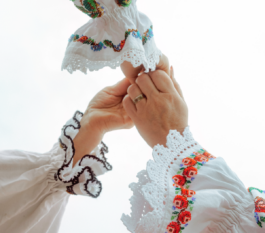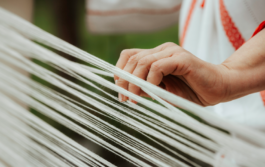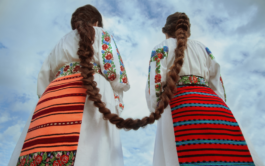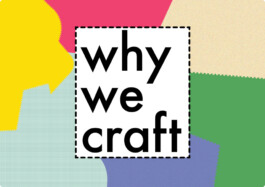Traditional Craftsmanship and the Six Basic Human Needs: Pathways to Sustainability & Fulfilment
Part I: Love, Certainty, Novelty
Written by Laura Aprilescu for #WhyWeCraft Stories
"If you traumatise people, if you disempower them, if you take away their spiritual place in the universe, if you deprive them of meaning and dignity, if you take away their ways of making a living, if you destroy their communities and you keep this going for generations, then the need for soothing and relief becomes entrenched in those communities. And the trauma is passed on from one generation to the next, because parenting styles are inherited not genetically, but biologically, behaviourally and psychologically."
This quote by trauma specialist Gabor Maté inspired us to look at the value of crafts and craftsmanship throughout time and how it has contributed and still contributes to the emotional well-being of communities worldwide. In a time when people seemed to be living more in the present moment, and the world seemed to be turning at a slower pace, crafts represented essential refuges in people’s lives and the seamless connectors between individuals.
In this two-part article, we explore some of the ways in which traditional crafts helped meet the six basic human needs as formulated by psychologist Cloé Madanes, convinced of their vital role in doing the same in the future.
Traditional crafts and the need for Love and Connection
The need for love and connection is linked to the attachment of humans to their loved ones, to their communities and the places they live in, as well as their inner selves.
An example of the importance of crafts in people’s lives is this story from the 1950s Romania, when the Soviet takeover was permeating its territories and the Communist government started the infamous Bărăgan deportations. In this Gulag-style experiment, over 40,000 people were brutalised and forced to leave their communities (Marineasa and Vighi, 2020; Vultur, 1995).
It was in the last moments before deportation that many peasant women of the Banat region rushed to bury their richly embroidered Blouses, which they saw as true encapsulations of their life stories, into the grounds of their villages (Halunga, 2020).
This was their defiant act of trying to preserve their identity, as well as a nod to their attachment to their native lands and to the lives they had built.
Some of the women managed to survive the harsh conditions and found their way back to Banat after many years of trauma and isolation. It was then that the Blouses on which they had embroidered their inner worlds could once again see the light of day, and perhaps help reconnect them to themselves (Halunga, 2020).
Traditional crafts and the need for Certainty
Another basic human need that has long been connected to traditional craftsmanship is the need for certainty, often connected to organisation, planning, knowledge, communication, safety and stability.
A historic example is the symbolic role of the Khadi cloth and the Swadeshi movement in India's fight for independence from British rule. Right after the First World War, on the backdrop of British imperialism in the Indian subcontinent, Mahatma Gandhi decided to devote himself to the renaissance of the Indian and Bengali textile arts.
Images of him spinning in public carry to this day his vision of a nation building its self-reliance through culturally, economically and environmentally sustainable traditions.
Gandhi had a hands-on approach to this ideology. He spotlighted the value of practicing spinning and weaving regardless of sex, age or class, in a time when India’s raw materials were entirely exported to England and then re-imported as expensive finished cloth, thus depriving the natives of work, profits and, ultimately, a chance of independence (Bhattacharya, 1976).
Khadi - the fabric of India's Independence - and the wider Swadeshi movement brought a deeply needed sense of certainty across the country, which now believed in its possibilities to be self-sustainable, and ended up being a key element in gaining independence from the British rule.
India’s national flag was inspired by the version initially envisioned by Pingali Venkayya and Gandhi, which included a traditional spinning wheel in the centre, and nowadays Indian law mandates that all flags have to be made of Khadi cloth.
Traditional crafts and the need for Novelty
A brilliant example that shows the link between crafts and the essential need for newness are the dazzling Azulejos.
A form of Portuguese and Spanish ceramic tilework, Azulejos represent a major cultural symbol of Iberia. Of Arab origin and with a history going back to the 13th century, these tiles have been enriched time and time again through the Iberian passion for change, exploration, and travelling.
Spanish and Portuguese artisans have since embedded Italian, Flemish, Indian and Dutch influences, and the modern Art Nouveau and Art Deco movements have further inspired new layers of artistry (Buono, 2015). Generation after generation, the craftspeople saw Azulejos as a dynamic medium, in which this creative freedom could fuel their search for variety and novelty. They reimagined the Azulejo compositions in various styles, from the baroque, blue-and-white tiles to the more geometric ‘Azulejo de tapete’.
Talented visual storytellers, Iberians, and later many Latin American craftspeople, saw the endless possibilities of the Azulejos and turned them into identitary art by immortalising scenes from their national history, mythology, or from the lives of saints or the Bible (Buono, 2015).
Nowadays they are found in churches, palaces, houses, institutions, restaurants, and even in subway stations. The variety of their colour palette and patterns is, to this day, an enchantment for both locals and travellers.
References:
Bhattacharya, S., 1976. “Cotton Mills and Spinning Wheels: Swadeshi and the Indian Capitalist Class”, 1920-22. Economic and Political Weekly, 11(47), 1828-1834. Retrieved August 26, 2021, from http://www.jstor.org/stable/4365116
Buono, A., 2015. “Historicity, Achronicity, and the Materiality of Cultures in Colonial Brazil”. Getty Research Journal, (7), 19-34. doi:10.1086/680732
Halunga, O., 2020. Povestea Iei/Timiş: Iile îngropate la Sânnicolau Mare de ţărăncile deportate în Bărăgan. [online] Agerpres.ro. Available at: https://www.agerpres.ro/cultura/2020/06/24/povestea-iei-timis-iile-ingropate-la-sannicolau-mare-de-tarancile-deportate-in-baragan-comorile-banatului-de-campie--528682
Marineasa, V. and Vighi, D., 2020. The Romanian Riveter: Draft of A Requiem from The Pentecost ’51. Fragments On the Deportation in Bărăgan. [online] European Literature Network. Available at: https://www.eurolitnetwork.com/the-romanian-riveter-draft-of-a-requiem-from-the-pentecost-51-fragments-on-the-deportation-in-baragan-by-viorel-marineasa-daniel-vighi-translateed-by-antuza-genescu/
Vultur, S. 1995. “De la reconstitution ethnographique à travers les récits de vie”. Ethnologie Française, 25(3), 473-483. Retrieved August 25, 2021, from http://www.jstor.org/stable/40990061
Traditional Craftsmanship and the Six Basic Human Needs: Pathways to Sustainability & Fulfilment
Part I: Love, Certainty, Novelty
Written by Laura Aprilescu for #WhyWeCraft Stories
"If you traumatise people, if you disempower them, if you take away their spiritual place in the universe, if you deprive them of meaning and dignity, if you take away their ways of making a living, if you destroy their communities and you keep this going for generations, then the need for soothing and relief becomes entrenched in those communities. And the trauma is passed on from one generation to the next, because parenting styles are inherited not genetically, but biologically, behaviourally and psychologically."
This quote by trauma specialist Gabor Maté inspired us to look at the value of crafts and craftsmanship throughout time and how it has contributed and still contributes to the emotional well-being of communities worldwide. In a time when people seemed to be living more in the present moment, and the world seemed to be turning at a slower pace, crafts represented essential refuges in people’s lives and the seamless connectors between individuals.
In this two-part article, we explore some of the ways in which traditional crafts helped meet the six basic human needs as formulated by psychologist Cloé Madanes, convinced of their vital role in doing the same in the future.
Traditional crafts and the need for Love and Connection
The need for love and connection is linked to the attachment of humans to their loved ones, to their communities and the places they live in, as well as their inner selves.
An example of the importance of crafts in people’s lives is this story from the 1950s Romania, when the Soviet takeover was permeating its territories and the Communist government started the infamous Bărăgan deportations. In this Gulag-style experiment, over 40,000 people were brutalised and forced to leave their communities (Marineasa and Vighi, 2020; Vultur, 1995).
It was in the last moments before deportation that many peasant women of the Banat region rushed to bury their richly embroidered Blouses, which they saw as true encapsulations of their life stories, into the grounds of their villages (Halunga, 2020).
This was their defiant act of trying to preserve their identity, as well as a nod to their attachment to their native lands and to the lives they had built.
Some of the women managed to survive the harsh conditions and found their way back to Banat after many years of trauma and isolation. It was then that the Blouses on which they had embroidered their inner worlds could once again see the light of day, and perhaps help reconnect them to themselves (Halunga, 2020).
Traditional crafts and the need for Certainty
Another basic human need that has long been connected to traditional craftsmanship is the need for certainty, often connected to organisation, planning, knowledge, communication, safety and stability.
A historic example is the symbolic role of the Khadi cloth and the Swadeshi movement in India's fight for independence from British rule. Right after the First World War, on the backdrop of British imperialism in the Indian subcontinent, Mahatma Gandhi decided to devote himself to the renaissance of the Indian and Bengali textile arts.
Images of him spinning in public carry to this day his vision of a nation building its self-reliance through culturally, economically and environmentally sustainable traditions.
Gandhi had a hands-on approach to this ideology. He spotlighted the value of practicing spinning and weaving regardless of sex, age or class, in a time when India’s raw materials were entirely exported to England and then re-imported as expensive finished cloth, thus depriving the natives of work, profits and, ultimately, a chance of independence (Bhattacharya, 1976).
Khadi - the fabric of India's Independence - and the wider Swadeshi movement brought a deeply needed sense of certainty across the country, which now believed in its possibilities to be self-sustainable, and ended up being a key element in gaining independence from the British rule.
India’s national flag was inspired by the version initially envisioned by Pingali Venkayya and Gandhi, which included a traditional spinning wheel in the centre, and nowadays Indian law mandates that all flags have to be made of Khadi cloth.
Traditional crafts and the need for Novelty
A brilliant example that shows the link between crafts and the essential need for newness are the dazzling Azulejos.
A form of Portuguese and Spanish ceramic tilework, Azulejos represent a major cultural symbol of Iberia. Of Arab origin and with a history going back to the 13th century, these tiles have been enriched time and time again through the Iberian passion for change, exploration, and travelling.
Spanish and Portuguese artisans have since embedded Italian, Flemish, Indian and Dutch influences, and the modern Art Nouveau and Art Deco movements have further inspired new layers of artistry (Buono, 2015). Generation after generation, the craftspeople saw Azulejos as a dynamic medium, in which this creative freedom could fuel their search for variety and novelty. They reimagined the Azulejo compositions in various styles, from the baroque, blue-and-white tiles to the more geometric ‘Azulejo de tapete’.
Talented visual storytellers, Iberians, and later many Latin American craftspeople, saw the endless possibilities of the Azulejos and turned them into identitary art by immortalising scenes from their national history, mythology, or from the lives of saints or the Bible (Buono, 2015).
Nowadays they are found in churches, palaces, houses, institutions, restaurants, and even in subway stations. The variety of their colour palette and patterns is, to this day, an enchantment for both locals and travellers.
References:
Bhattacharya, S., 1976. “Cotton Mills and Spinning Wheels: Swadeshi and the Indian Capitalist Class”, 1920-22. Economic and Political Weekly, 11(47), 1828-1834. Retrieved August 26, 2021, from http://www.jstor.org/stable/4365116
Buono, A., 2015. “Historicity, Achronicity, and the Materiality of Cultures in Colonial Brazil”. Getty Research Journal, (7), 19-34. doi:10.1086/680732
Halunga, O., 2020. Povestea Iei/Timiş: Iile îngropate la Sânnicolau Mare de ţărăncile deportate în Bărăgan. [online] Agerpres.ro. Available at: https://www.agerpres.ro/cultura/2020/06/24/povestea-iei-timis-iile-ingropate-la-sannicolau-mare-de-tarancile-deportate-in-baragan-comorile-banatului-de-campie--528682
Marineasa, V. and Vighi, D., 2020. The Romanian Riveter: Draft of A Requiem from The Pentecost ’51. Fragments On the Deportation in Bărăgan. [online] European Literature Network. Available at: https://www.eurolitnetwork.com/the-romanian-riveter-draft-of-a-requiem-from-the-pentecost-51-fragments-on-the-deportation-in-baragan-by-viorel-marineasa-daniel-vighi-translateed-by-antuza-genescu/
Vultur, S. 1995. “De la reconstitution ethnographique à travers les récits de vie”. Ethnologie Française, 25(3), 473-483. Retrieved August 25, 2021, from http://www.jstor.org/stable/40990061
Endorsed by

Powered by

Project developed under the umbrella
of the Cultural Intellectual Property Rights Initiative®

This activity was a winner of the 2020 EU Social Innovation Competition from the European Union’s Horizon 2020 research and innovation programme.

Follow us
Our Linkedin page
Instagram Community
Our Youtube channel (soon)
© 2021-2024 Asociația WhyWeCraft, all rights reserved - WhyWeCraft®
LEARN WITH US
WORK WITH US

BE PART OF THE MOVEMENT FOR CULTURAL SUSTAINABILITY IN FASHION
Endorsed by

Powered by

Project developed under the umbrella
of the Cultural Intellectual Property Rights Initiative®

This activity was a winner of the 2020 EU Social Innovation Competition from the European Union’s Horizon 2020 research and innovation programme.

Follow us
Our Linkedin page
Instagram Community
Our Youtube channel (soon)
© 2021 Asociația WhyWeCraft, all rights reserved - WhyWeCraft®


